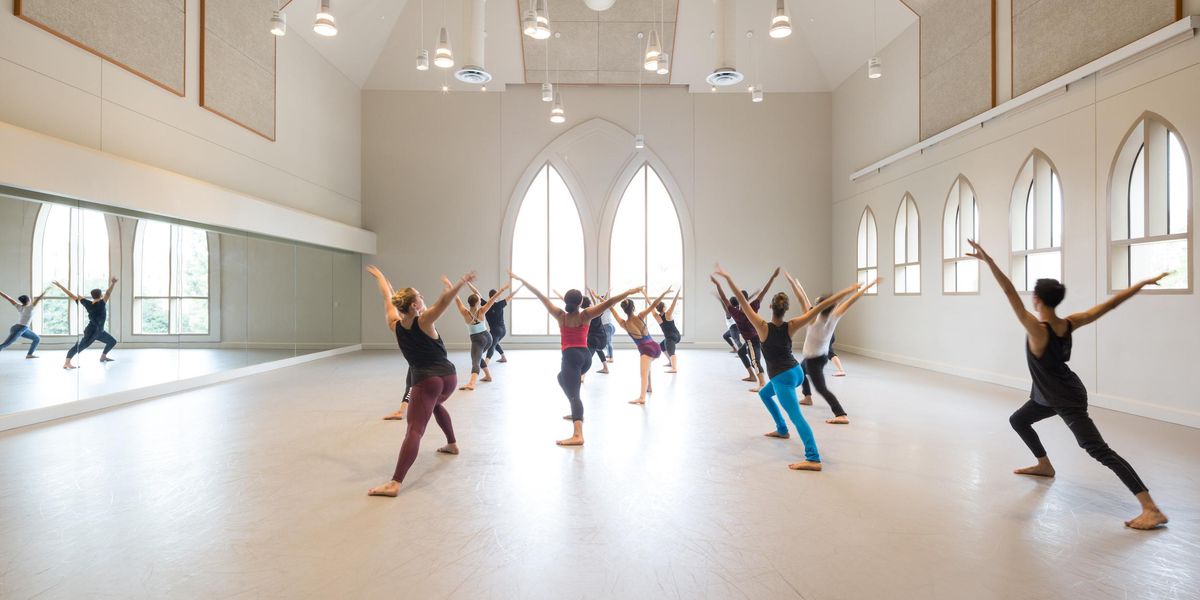Dorrance Dance Unlocks Tap for Everybody
Michelle Dorrance performing at Jacob’s Pillow in 2013. Photo by Christopher Duggan.
Last summer Michelle Dorrance’s Blues Project at Jacob’s Pillow was such a hit that she was invited back for two weeks this summer. A two-week run—practically unheard of at the Pillow! Judging from a rehearsal I saw yesterday, she’s got another hit on her hands—and it opens on Wednesday.
It’s not only that her own performing draws you into its irresistible sense of fun. Or that she can put forward big concepts and fulfill them with craft and craftiness. Or that she allows each of the dancers to own their individuality onstage. It’s also that she seems to have found a key to unlock all of tap dance for any audience. The dancers put their whole bodies into the effort to create sound, engaging spatially in a way that’s rare in tap. And the tapping is terrific.
The big concept for this new piece, ETM: The Initial Approach, is how movement and sound affect each other within the sonic design set up by Nicholas Van Young, who also performs. He’s given each dancer a segmented platform that gets activated through contact, triggering different sounds in each part of the platform. It’s exciting to see/hear as, collectively, the dancers create and build and become an orchestra. (Note: I believe ETM stands for Electronic Tap Music.)
The freshness to Dorrance’s approach resides in this fact: She is not making “numbers.” These scenes will not fit into a So You Think You Can Dance slot. There is real choreography sprinkled with real improvisation. Although there’s no narrative, you’re pulled along by the dancers’ giddy exploration of the sound design as well as their relationship to each other.
When b-girl Ephrat “Bounce” Asherie almost plows into long-and-loose Warren Craft, they look like two different species of animal playing together. When Caleb Teicher—he of the large eyes and soulful look— intersects with Elizabeth Burke, it’s the beginning of a pas de deux. When Dorrance aims a burst of improv at one of the dancers, you see how she changes the room.
Adding to this mix is vocalist Aaron Marcellus, whose dreamlike, exotic-sounding singing (with, like all else in the show, the help of electronic looping and reverb), meshes beautifully with Dorrance’s quirky, athletic style.
This piece is obviously influenced by Dorrance’s four years in Stomp. For one thing, sound designer Young is a fellow ex-Stomper. He and Dorrance share a fascination with textures (metal slats, chains) and the ways they can change sound and motion. Just as Stomp did, ETM: The Initial Approach teaches the dancers to connect movement with sound, and teaches us to connect seeing to listening. The piece moves seamlessly from quiet and subtle to brash and boisterous.
As Brian Seibert pointed out in this story from last year, improvising was always part of Dorrance’s repertoire. Her mischievous mix of set choreography for the group and individual on-the-spot solos and duets is beguiling. She’s a Pied Piper out there; her energy is contagious. In the last lap, when each dancer tears across the space in their own style to tap a sound box on the other side, you see how she has set people free.
Performances are July 16–19 & and July 23–27. For more info, click here.
Photos: At left: Ephrat “Bounce” Asherie, in rehearsal; Lower right: from left: Leonardo Sandoval, Karida Griffith, and Dorrance.




